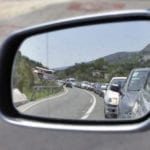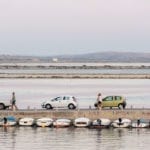Driving to your holiday destination is exciting, but the excitement can soon deflate as you find yourself stuck in a traffic jam. But don’t worry, we’ve got you covered!
Ok, the day has come and you’re leaving on your well-earned vacation. If you’re thinking how Saturday is a great first day of your holiday, think again. Most people go or return from their vacations during the weekend, often creating traffic jams that span for kilometers. Be smart about planning your vacation by travelling during work days, preferably in the middle of the week, and have a smooth drive to your destination.
Similar to weekends, be sure to check Croatian state holidays which are a very popular time for seaside vacations.
It’s also good idea to know more than one route to the place you’re driving to. You never know what could cause a reroute, so better be on the safe side and learn alternative routes.
Holiday season ensures traffic jams at most border crossings, so be sure to know alternative ones. For example, Bregana is the biggest and most popular border crossing between Croatia and Slovenia, but there are actually 27 other border crossings you can take, the closes to Bregana being Harmica and Naselje.
Bosnia and Herzegovina shares a 1000 km border with Croatia, along with 25 border crossings to choose from. Those coming from Hungary should try to avoid the Duboševica border crossing and try Terezino Polje, Donji Miholjac, Gola or Goričan.
Travelling by night, or at dawn can be a good option if you’re looking to evade traffic jams. Most people usually don’t want to start their vacation with a 2 a.m. alarm, so you can beat them to the punch and reach your summer destination by morning.
Have technology on your side
Here is something really useful – Croatia traffic info is a website and app that gives you real-time information on traffic flows, border control and ferry traffic. There is also a radio station called HRT2 which has traffic news for foreigners on several languages. Because the station’s frequency band (MHz) changes as you drive, you can see the signs with the number of the station all along Croatian highways.
When you’re travelling via highways, most common slow-moving traffic occurs at paytolls. You can anticipate this situation by paying by ETC (electronic toll collection). It is a contactless toll collection method without any mediation of a toll attendant in which the toll collection process is conducted by means of an ETC-device mounted on the windshield of the driver’s car and the antenna in the toll lane. Another way to get through the pay toll smoothly is to use your credit card to pay. Just insert it in the designated slot, and after it slips out, collect your bill and drive on.
Weathering the weather
Because of winds blowing from the sea (bura), the Croatian coast often has some tricky driving conditions. Bura can get up to speeds of 155 km/h which is a safety hazard for drivers, so it is not peculiar for a road to be partially closed for traffic.
If you’re travelling to Pag, be sure to check if the Pag bridge is opened for traffic. Due to powerful surges of bura it often has to be closed.
And last but not least, it’s easy to forget how important it is to rest while driving long distance. Getting to your destination and starting your vacation seems urgent, but being alert and rested on the road is a priority. There are plenty of rest areas along Croatian roads and highways, so have a breather, stretch your legs and have some coffee. And don’t worry, you’ll get there. 🙂
Now when there’s no way of you ever getting stuck in a traffic jam, there’s nothing stopping you in booking your next vacation!
View accommodation offers in Camping Village Šimuni on island of Pag.

